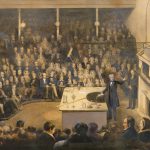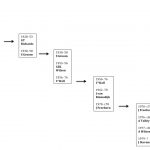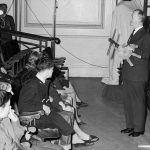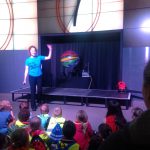Threading through history: the vertical transmission of Davy, Faraday and Tyndall’s lecture demonstration practices
Article DOI: https://dx.doi.org/10.15180/160604
Abstract
This essay explores the extent to which residues of the practices inherent in nineteenth-century science lecture-demonstrations from the Royal Institution of Great Britain (RI) are evident in contemporary forms of Science Museum Group (SMG) Explainer presentations. The discipline of Performance Studies offers a number of models to discuss such a consideration and this essay draws particularly on the connected, transgenerational theories of vertical transmission, embodied knowledge and intertheatricality. Specifically, the focus is on three notable scientists, selected here for their particular influence on the lecture-demonstration practices at the RI during the nineteenth century: Humphry Davy, Michael Faraday and John Tyndall. It suggests that aspects of their embodied performances in the lecture theatre have been transmitted through subsequent generations of RI practitioners. Extending this transmission, via specific events in 1954 that led to Science Museum Guide Lecturers observing RI practices, it suggests that these practices were then inherited and passed down through generations of lecturing and explaining staff at the museum.
Keywords
Embodied knowledge, Explainer, intertheatricality, lecture-demonstration, Royal Institution, Science Museum, vertical transmission
Introduction
https://dx.doi.org/10.15180/Reflecting on his experience of delivering a Discourse at the RI in 2013, Stephen Curry, Professor of Structural Biology at Imperial College London observed:
The sense of occasion is heightened by the connection with the past. The fact that I have given a Friday Evening Discourse at the Royal Institution will warm the cockles of my heart for the rest of my days because there is now a thread through history that connects me to previous speakers, the likes of Faraday, Huxley, Rutherford and Hodgkin. I claim no degree of equality with these celebrated scientists — seriously, I don’t — but that slender, unbreakable thread tickles me.
The notion of Curry’s ‘slender, unbreakable thread’, tying his own performance back through history to those speakers and their presentations given in the same place up to 200 years before him, presents a tantalising opportunity for the historian of embodied knowledge: how to evaluate the residue of these earlier forms reverberating in the space once again – re-constituted, re-embodied and re-presented through Curry’s contemporary actions. This essay introduces three concepts from the field of Performance Studies[1] as possible frameworks for addressing this challenge, exploring them first in the context of nineteenth-century lecture-demonstration practices at the RI, before moving to illustrate how these connect with mid-twentieth century Science Museum practices, and finally, with contemporaneous practices within the SMG.
Vertical transmission: Watson and Schechner
https://dx.doi.org/10.15180/160604/002The notion of vertical transmission as it is applied to performer training practices and performance transmission has been variously discussed (Pitches, 2015 & 2011; Evans, 2009; Watson, 2001; Schechner, 1985) with one critical issue of commonality being a focus on aspects of physical skill and embodied knowledge. It is useful in this context for the ways in which it helps explain the construction of what has been termed a ‘physical storyline’ (Pitches, 2011, p 141) depicting, in this case, how nineteenth-century lecture demonstration practices have been transmitted through the twentieth and on to the twenty-first centuries.
In Performer Training: Developments Across Cultures Ian Watson elaborates on his adoption of the term ‘vertical transmission’ (Watson, 2001, p 3), describing the practice of performance skill and embodied knowledge being handed down from one generation to the next as being part of a broader tradition that he classifies as ‘direct training’ (Watson, 2001, p 2).[2] Watson’s examples include traditional East Asian forms such as Japanese Noh theatre, the Indian dance-drama Kathakali, and Balinese dance, where the focus is on specific skills being taught by masters to apprentices, the aim being to transmit a precise codified language relating to an established repertoire, with little deviation from the master’s performance. He offers perhaps the most fundamental example of vertical transmission in Japanese Kabuki theatre, where on retirement a great actor passes on to one specially chosen pupil not only his skills and embodied knowledge, but also his actual name (Watson, 2001, p 3). Richard Schechner (1985) also turns to early East Asian forms in his discussion of the embodied ways in which performance traditions are first embedded and then passed on in different cultures. He goes significantly further in historical terms to suggest that such practices are likely to have been established in ‘what might have been the world’s earliest theater, the events occurring within the paleolithic caves of southwest Europe’ (Schechner, 1985, p 22) some twenty-five thousand years ago. Schechner notes a similar pattern in theatre training: ‘Theater people know about training; it is expected that teachers of theater be able also to practice it’ (Schechner, 1985, p 25). In these models the passing on of skills is deliberately structured around the notion of ‘imitation’, critical to theories of vertical transmission, and there is usually an explicit sense of a ‘master-disciple’ relationship (Schechner, 1985, p 23).
In the ‘V’ section of A Lexicon of Training Terms, Brayshaw et al also define the term:
Verticality is the embodied transmission of training knowledge and skill from one generation to the next, usually in a specific training context which allows for a deep and long-lived relationship between the trainer and trainee. Because of its association with generational transmission, verticality is often referred to as occurring within a training ‘family’ – from surrogate father to son but much less often from surrogate mother to daughter.
(Brayshaw et al, 2012, p 397)
As with Watson’s and Schechner’s interpretations verticality in this definition is primarily concerned with the notion of repetition and replication, rather than a practice that reinterprets and rediscovers. But noteworthy, here, is the suggestion that the vertical relationship privileges the passing on of embodied skills from ‘surrogate father to son’. This is in contrast to the etymological root of vertical transmission from medical science, which denotes a mother-child descent:
Vertical transmission: Passage of a disease-causing agent (pathogen) from mother to baby during the period immediately before and after birth.
The western adoption and re-positioning of the term in a performer-training context to describe a male-oriented hierarchical relationship reveals much about the patriarchal domination of the field and it is only in the latter part of the twentieth century that women have been seen to play a credible role in western performer training practices.[3] In the parallel domain of the RI, practitioners during the nineteenth century were exclusively male. Indeed, with only a minority of exceptions, this prevalence has persisted, and similarly, it was not until the 1990s that women began to be regular practitioners of lecture-demonstration practices.[4]
Embodied knowledge transmission: Roach, Taylor and Carlson
https://dx.doi.org/10.15180/160604/003Before applying this idea to the context of the RI and the Science Museum it is necessary to extend the framework of Performance Studies theories to bolster ideas of verticality. In the following two sections I synthesise a complex of conceptions from Joseph Roach, Diana Taylor, Jacky Bratton and Marvin Carlson under the term ‘embodied knowledge transmission’, to understand the mechanisms by which verticality is achieved. Schechner’s notion of ‘restored behaviour’ is a good starting point:
Physical, verbal, or virtual actions that are not-for-the-first time; that are prepared or rehearsed. A person may not be aware that she is performing a strip of restored behaviour. Also referred to as twice-restored behaviour.
(Schechner, 2006, p 29)
Restored behaviour hinges on the perception that all human behaviours are multi-authored composites of actions that have already been practised, that the ‘units of behaviour that comprise “me” were not invented by “me”’ (Schechner, 2006, p 35). Positioning Schechner’s restored behaviour as ‘fundamentally repetitive or reiterative (…) necessarily bring[ing] back the past to unsettle the present’, performance historians Gilli Bush-Bailey and Jacky Bratton (2011, p 100) show how it offers one approach to dealing with the impact of historical performance events in the present day. Research into performance history, in this instance the performance of RI nineteenth-century lecture-demonstrations, presents a specific problem, one that Joseph Roach refers to as ‘the issue of absence [in] performances of the distant past’ (Roach, 1996, p 2) due to its transient and ephemeral form. Roach observes that one significant method of approach used by performance researchers today is to ‘juxtapose living memory as restored behaviour’ against the available tangible archival material, an approach that is useful to this enquiry.[5] By suggesting that living memory can be a form of restored behaviour, Roach implies that behaviours and actions from a previous time can be unknowingly trained for and practiced, and leave an imprint on the corporeal and cerebral faculties of those living who encounter traces of those past behaviours. In this sense it is as though the legacy of a particular skill or style of performance may be recreated, or restored, in present actions some time after the original has ceased. Important to note here is Schechner’s assertion that no two performances/restored behaviours are exactly the same – the contexts and conditions of reception are unique – but that thinking about performance in the sense of restored behaviour means it is never uniquely for the first time: ‘Performance means: never for the first time. It means: for the second to the nth time. Performance is “twice-behaved behaviour’’’ (Schechner, 1985, p 36).
Diana Taylor (2003) expands this idea by drawing a distinction between ‘the archive and the repertoire’. As Gale and Featherstone observe, ‘For Taylor, the historical prioritisation of the text-based archive has meant the repertoire […] has been given less significance than it might have been’ (Gale and Featherstone, 2011, p 20). Taylor is particularly interested in the ways in which knowledge is produced and transmitted through embodied means. In making the distinction between the hard, tangible contents of the archive, ‘supposedly enduring materials (i.e. texts, documents, buildings, bones)’ and what she refers to as ‘the so-called ephemeral repertoire of embodied practice/knowledge (i.e. spoken language, dance, sports, ritual)’ (Taylor, 2003, p 19 italics in original), she highlights how the former separates the knowledge from the knower. Taylor argues that unlike the objects in the archive, which although open to interpretation essentially remain constant, the actions of the repertoire are flexible and unfixed:
The repertoire requires presence: people participate in the production and reproduction of knowledge by “being there”, being a part of the transmission.
Taylor, 2003, p 20
This transmission may incorporate changes and additions as the participants appropriate the embodied knowledge. As with Schechner’s restored behaviour, Taylor recognises the possibility of a state of ‘againness’ (Taylor, 2003, p 21), acts of behaviour that are played out in subtly different forms with each new iteration, as if the memory is being replayed, ‘They reconstitute themselves, transmitting communal memories, histories, and values from one group/generation to the next’ (Taylor, 2003, p 20).
This idea intersects with what Marvin Carlson in The Haunted Stage refers to as ‘recycling’ (2003), a concept he applies to theatrical text, body, production and space. Building on the notion that ‘all texts are in fact haunted by other texts and can be best understood as weavings together of preexisiting textual material – indeed, that all reception is based upon this intertextual dynamic’ (Carlson, 2003, p 17), he argues that all the constituent parts of all theatrical production have been recycled or reused, an idea that complements Schechner’s notion of restored behaviour.
Accepting that nineteenth-century lecture-demonstrations and the work of the Explainer antecedents at the Science Museum constitutes performance, this framework of embodied knowledge transmission from Performance Studies might help explain the embodied history of contemporary forms of SMG explaining, suggesting it as a ‘reusing’ of nineteenth-century lecture-demonstration performance, a central tenet of my argument here.
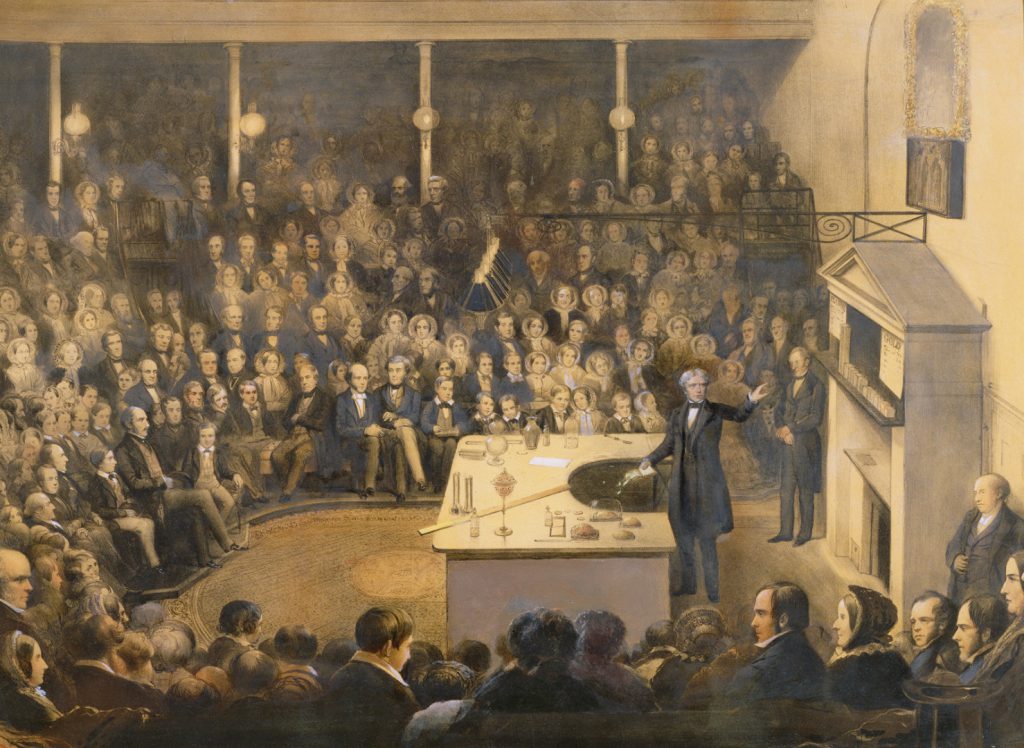
The extant documentation of these nineteenth-century performances takes a variety of forms including written eyewitness accounts, the letters, lecture-notes and diaries of the scientists themselves, and lithographs – the mediatising paraphernalia of the time – and this documentation contributes to and enhances re-presentation and re-imagining. In the instance of RI lecture-demonstrations there is also a further layer of complexity since the performance here is of the production of scientific knowledge – the lecture-demonstrations were/are tangible and physical, if fleeting moments of its presentation. Once the moment of performance has passed, the remaining capital – the knowledge itself – resides in the memories and experience of the spectator and the scientist-practitioner. Later still it may also be present in any associated written, visual or aural documentation. In this respect there are echoes of Diana Taylor’s positioning of performance as something ‘which persists, transmitted through a nonarchival system of transfer that [she] came to call the repertoire’ (Taylor, 2003, p xvii). Taylor, as I have said, identifies the repertoire as that which ‘enacts embodied memory: performances, gestures, orality, movement, dance, singing – in short, all those acts usually thought of as ephemeral, nonreproducible knowledge’ (2003, p 20). The lecture-demonstration practices of the nineteenth century have not before been thought of in this way, but considering them as part of a repertoire appropriately recognises how the embodied traditions of two hundred years ago have, in Taylor’s words, been ‘transmitted “live” in the here and now to a live audience. Forms handed down from the past are experienced as present’ (Taylor, 2003, p 24). The ‘here and now’ practices at the RI remain little altered since their earliest days, but as I argue later, traces of them also reside in the ‘here and now’ practices of the SMG Explainer.
Embodied knowledge transmission: Bratton and intertheatricality
https://dx.doi.org/10.15180/160604/004Marvin Carlson’s aforementioned concept of ‘recycling’ chimes with another important theoretical framework for this article – Jacky Bratton’s notion of ‘intertheatricality’ (Bratton, 2003, pp 37–8). In New Readings in Theatre History (2003) Bratton articulates a new theorisation of the transactions in theatre in which she envisages a ‘mesh of connections between all kinds of theatre texts, and between texts and their users’ (2003, p 37). Focusing particularly on theatrical performance in London in the 1830s, Bratton uses the material remains of playbills to investigate the ways in which audiences were able to read and interpret performances by building on their previously acquired experiences of both the specific contexts of the performance itself, and of all the associated contexts – reputation of performers, other roles played or other interpretations of the same role, for instance. Bratton’s concept of intertheatricality capitalises on building the ‘knowingness’ (2003, p 37) that comes from the experience and memory of particular performances, and their contexts, and suggests that many forms of performance can be retained by spectator and performer as part of the shared language of a system that will ultimately shape and enhance individual interpretations of future performances yet to be seen and made.
William N West’s essay Intertheatricality (2013) exploring reverberation and repetition in Elizabethan theatre uses Bratton’s concept as a starting point. As with aspects of my own investigation, West is particularly interested in the reiteration of action and gesture in performance and how this can result in experiences that seem familiar for audiences and performers. He suggests that ‘to look in an “intertheatrical” way – is to seek shared memories of actions that can be called up to thicken present performances’ (West, 2013, p 155). As we shall see, this description of past actions ‘thickening’ those in the present resonates with my location of the roots of twentieth and twenty-first century Science Museum Lecturer and Explainer performance actions in nineteenth-century RI lecture-demonstration practices. Of even greater interest here is West’s overarching definition of intertheatricality:
Rather than seeing different patterns and forms of performance as variations on a fixed type (…) it understands them as belonging to a horizontally organised repertoire, never completed and slowly changing, of lines, gestures, characters, situations, genres, and other smaller elements that cumulatively allow for new performances and new concatenations of actions. Let us call this way of looking at playing its “intertheatricality”.
West, 2013, p 156
Here, in a description that echoes Bratton’s conception, West envisages new performance as something that repeatedly evolves out of other existing performances, but that moves ‘horizontally’, within one time frame (in his example, the Elizabethan age).[6] Bratton’s theory contains a potentially limiting factor through her suggestion of interdependency amongst the various entertainments and dramas ‘that are performed within a single theatrical tradition’ (2003, p 38). I posit here that physical traces of the RI nineteenth-century lecture-demonstration practices have lingered and endured and, over an extended period of time, can be said to have become intertheatrically enmeshed with elements of other forms of performance, re-emerging in the performance practices of the twenty-first-century SMG Explainer. The context I narrate here suggests that Bratton’s idea of intertheatricality can be expanded beyond the single tradition of theatre. Before elaborating on that claim, and having established a framework for the historical analysis of lecture demonstration practices, let me now return briefly to the details of the vertical transmission of embodied knowledge with specific reference to the ‘master-scientists’ of the RI.
Vertical transmission at the RI: Davy, Faraday and Tyndall
https://dx.doi.org/10.15180/160604/005Notions of the artifice of performance are not new to readings of scientific lecture-demonstration, and descriptions of them that utilise theatrical metaphor are plentiful.[7] Commending the application of performance theory for the ‘new, nontextual strategies’ (Morus, 2010, p 775) it can offer to understanding scientific practice, Iwan Rhys Morus observes that ‘[i]f knowledge is embodied, then we need to pay attention to its bodies’ (Morus, 2010, p 776). Here, my own exploration of the relationships between Davy, Faraday and Tyndall focuses on the physical, embodied practices apparent in their lecture-demonstrations and suggests a new interpretation of those relationships. Sophie Forgan’s study of the history of the RI maintains that it offers a ‘striking example of an institution where professorial lineages, research tutelage and personal influence on careers’ (Forgan, 2002, p 27) can be found in abundance, pointing out that the relationship between Davy and Faraday has been analysed as one of (surrogate) father and son.[8] This is certainly one plausible description of their association, not least because of the tensions and jealousies that sometimes arose between them (Morus, 1998, p 25) especially as the younger man, Faraday, began to carve his own successful career, ultimately establishing himself as the leading light at the RI. Here though, I suggest that their relationship, and later, Faraday’s relationship with John Tyndall, can equally profitably be examined within the framework of embodied knowledge transmission, and, specifically, through the lens of vertical transmission. In so doing, I propose that there was both a conscious and subconscious process of repetition and emulation of the presentation methods and techniques from one scientist-lecturer to the next. Although such a reading incorporates ideas of inheritance and transfer, it suggests a more deliberate influence than might be found within the father-son bond, emphasising an active intention to perpetuate existing physical practices and behaviours. Particularly emphasised in this process is the value of ‘imitation’ as has been said (Schechner, 1985, p 22; Watson, 2001, p 3), as well as the ‘master-disciple’ status relationship, in which the ‘master’ has significant experience as a practitioner in his or her own right.
The process of vertical transmission as an intergenerational embodied training practice naturally established itself amongst the three subjects (Davy, Faraday and Tyndall).[9] In this model each of the scientist-lecturers is an expert practitioner themselves – both in the laboratory and the lecture theatre – as well as a source of inspiration for the next generation. Compelling evidence of Faraday’s adoption of a model of imitation comes from his own writing. In the first of a sequence of four letters to his friend Benjamin Abbott, written between 1 June and 18 June 1813, Faraday reflects on his own journey towards becoming a lecturer and his experiences of watching others, particularly Davy at work, noting that ‘’tis evident that I have yet to learn and how to learn better than by the observation of others’ (James, 1991, p 55). Faraday’s instinct, then, was for a process that enabled him to cultivate his own practice through the close scrutiny of others.
It would, of course, be misleading to suggest that such deep and intentional vertical transmission occurred from Davy to Faraday to Tyndall as that described by Watson in relation to East Asian forms of performance. Nevertheless, it is widely accepted that Faraday was inspired by Davy, and in turn, that Tyndall was greatly influenced by Faraday’s performance in the lecture theatre as well as benefitting from a form of mentoring by him in his own early lecturing career at the RI (De Young, 2011, p 78; Eve and Creasey, 1945, p 44). In her study of Tyndall and the role of the scientist in Victorian culture, Ursula de Young cites Tyndall’s own journal entry from 29 December 1853 in which he describes the possibility of inheritance from Faraday:
Once he turned his face towards me with kindness and at the same time chastened by something higher. Tyndall, he said, I should like you to love this Institution, to identify yourself with it. In the course of nature I shall soon pass away – and he said something else which seemed to indicate that he wished me to fill his place.
De Young, 2011, p 80
This insight into Faraday’s presumed intentions bears all the hallmarks of a master passing down his legacy to a chosen apprentice, in the same way that Faraday himself ultimately succeeded his mentor Davy as the ‘most popular scientific lecturer in London’ (James, 2007, p xv). This opportunity for direct vertical transmission was naturally established and fostered amongst them. Indeed, the RI lecture theatre itself can be viewed as a kind of training ground for future scientist-lecturers, where they could test out practices and approaches inspired by what they witnessed in the performances of others, selecting from those performances the methods and physical tropes that they wished to recreate for themselves.
Intertheatrical readings and embodied practices in the RI context
https://dx.doi.org/10.15180/160604/006So how does this transmission of knowledge relate to Bratton’s conceptualisation of intertheatricality, what she calls a ‘knowingness’ (2003, p 37), built on the individual’s experiential memory of performances and their contexts and influencing all their future interpretations? For Bratton, and others who have expanded her theory (e.g. West, 2013), this process occurs horizontally in that its effects reside within the individual and do not transcend generations. They are not, in addition, responsive to determined intent. Bratton envisages a network of connections stemming from multiple performance experiences that become woven together in the memory of the spectator, subconsciously shaping and influencing their reactions to, and understanding of each new performance experience they have. If one extends this essentially horizontal mode of thinking to incorporate the mechanism of vertical transmission the experiential memory of individual spectatorship (in Bratton’s model) becomes, instead, a transmission of intergenerational embodied knowledge. From this perspective the known physical presence of Faraday at Davy’s performances, and in turn, Tyndall’s documented observations of Faraday’s lectures can be said to have much more consciously and strategically shaped the formation of their own presentation styles.
Such a notion echoes Bloom et al’s (2013) interpretation of intertheatricality. They highlight the ‘lingering’ quality of performance and the possibility of ‘reverberation’ that might even be seen as ‘exploding the confines of synchronic temporality’ (Bloom et al, 2013, p 167). They hint at the possibility of performance that is reiterated in future time frames, surpassing Bratton’s singularity and West’s ‘horizontal’ boundaries. It is in this way that traces of the habits of Davy’s original presentational form and structure can be said to have persisted and been passed on, or ‘disseminated’ (Bloom et al, 2013, p 167), through the memories and, importantly, the embodied experience of subsequent generations of RI practitioners. Faraday’s close scrutiny of Davy’s performance methods in particular is well documented (James, 2002, p 122; Morus, 1998, p 19; James, 1991, pp 55–65; (Thomas, 1991), p 18). His four aforementioned letters to his friend Abbott in 1813 in which he describes the ‘most prominent requisite to a lecturer’ (James, 1991, p 60), and sets out his own ideal model, serve as clear evidence of his careful consideration of Davy’s performance and his own subsequent appropriation of certain techniques and rejection of others.[10] Faraday’s 1813 correspondence with Abbott reveals that he also observed several other RI lecturers at the time, and had the ‘opportunity to see at close quarters some of the best lecturers at work’ (James, 2010, p 91). Such a breadth of styles and content must surely have stimulated in Faraday an appreciation and interpretation of the ‘mesh of connections’ (Bratton, 2003, p 37) between them. Nevertheless, it is Faraday’s close affiliation with Davy and high regard for him that make Davy a particularly strong figure of influence for Faraday. Elements of West’s (2013) intertheatrical definition that accommodate a ‘slowly changing’ (2013, p 156) repertoire over time can be seen in Tyndall’s approach. Far showier and more spectacular in his lecturing style than his mentor, Tyndall ‘recognised that, because of his own quite different personality traits, he could never hope to bear Faraday’s unique “mantle” with the same effect’ (de Young, 2011, p 84). This is evidence, then, of an absorption of practices and techniques from master to disciple, but with ‘continually moving, dissolving and re-forming pattern[s]’ (Bratton, 2003, p 38) as the practice shifts and is re-invented from practitioner to practitioner.
Returning to Taylor’s (2003) tension between ‘archive and repertoire’ it can also be seen how first Davy’s, then Faraday’s, and later still Tyndall’s physical actions as lecturer-demonstrator form an ‘embodied repertoire’ that was/is transmitted through the subsequent generations of RI lecturer-demonstrators. Significantly, it is the actual physical presence of each of the scientists that ensures this transmission of the repertoire – ‘people participate in the production and reproduction of knowledge by “being there”’ (Taylor, 2003, p 20). As I have suggested, it is known for certain that they did indeed physically witness each other at work in this way, each of them participating in the production, reproduction and then transmission of the ‘flexible and unfixed’ actions of the embodied knowledge. In turn, ultimately each of them came to embody certain elements of those practices themselves, and the repertoire can be said to have been ‘restored’ (Schechner, 2006) in subtly different ways in their own practice.
The combination of tangible documentation (in this instance for example: Faraday’s letters and later his writings on training for lecturing, independent accounts of lectures given, pictorial images and later still televised lectures at the RI) and embodied practices may be assembled to construct a clear lineage of transmission. Furthermore, this lineage can be projected forwards to the period in the mid-1950s when Science Museum Guide Lecturers were physically present to observe the RI lecture-demonstrations of Professor Lawrence Bragg, the embodied repertoire of the nineteenth-century practices of lecturing living on and inspiring continued replication. This is one of the most important ways in which the lineage of the contemporary SMG Explainer can be traced back to locate one branch of its roots in nineteenth-century RI approaches. The fleeting moments of performance that constitute each lecture-demonstration become inscribed in the memories and experiences of those who witness them, and in the cases of the scientist-lecturers who follow on, the practices are re-imagined and re-presented through their own performances. To re-state Taylor’s idea, ‘Forms handed down from the past are experienced as present’ (Taylor, 2003, p 24). Crucially, Taylor insists that the ‘repertoire requires presence’ (2003, p 20), that in order for transmission to occur the physical presence of participants is a necessity and a process that enables a reiteration of already performed actions is kick-started. Faraday himself shared a similar view that physical presence could effect some form of change or influence. During a lengthy correspondence with Abbott during September 1812, in which he argues with him over the properties and effects of chlorine as demonstrated by Davy in a series of lectures that Faraday observed, he stresses the importance of actually being there in order to believe in and be altered or affected by what is seen:
I have seen Davy himself support it [.] I have seen him exhibit experiments conclusive experiments explanatory of it and I have heard him apply those experiments to the theory & explain and enforce them in (to me) an irresistible manner [.] Conviction Sir struck me and I was forced to believe him and with that belief came admiration [.]
James, 1991, p 19
In an early example of the physical transmission of ideas, Faraday’s writings reveal how he proposed the re-staging of what he had seen performed by Davy in order to persuade Abbott of his opinion, so that ‘the performance would give us a clearer idea’ (James, 1991, p 28). For Faraday, the presence of Abbott at such an event was critical to his belief that this would enable him to be influenced by what he had seen.
The significance of 1954
https://dx.doi.org/10.15180/160604/007The importance of presence as a pre-requisite for embodied transmission is of particular significance in relation to what I position as the inter-institutional transmission that occurred between the RI and the Science Museum in 1954, a ‘missing link’ in the histories of both organisations that is pivotal in the new historiography of the SMG with which my larger doctoral project is concerned.[11]
The Guide Lecturer role had been introduced at the Science Museum some thirty years earlier when, in 1924, a newly recruited Captain E Smith began giving twice-daily tours of the galleries. By 1954 the role had expanded to comprise a combination of gallery and lecture theatre lectures in science and engineering subjects, with two lecturers regularly delivering a total of sixty lectures between them. The then Director (1950-56) F Sherwood Taylor had first-hand experience of the lecture-demonstrations at the RI having himself delivered the 1952 Christmas Lectures, How Science has Grown. By this time the Christmas Lectures had been established and successful for over 125 years, and by presenting at the RI Sherwood Taylor had the opportunity to experience personally the powerful effect that observing practical science in action could have on an audience. The Science Museum Bulletin for Michaelmas Term 1955 offers the context for the first series of Special Lecture Demonstrations that were held in July of that year[12]:
A few years ago our Director, Dr. F. Sherwood Taylor, gave the famous Children’s Christmas Lectures at the Royal Institution, and he was so struck with the response and the enthusiasm which they aroused that he resolved to introduce some similar lectures in the Science Museum.[13]
The physical act of delivering the Christmas Lectures at the RI also forms an important connection between Sherwood Taylor and the line of scientists who have maintained the vertical transmission of lecture-demonstration practices since the nineteenth century, continuing Curry’s ‘slender, unbreakable thread’.
Sherwood Taylor’s active involvement in the unique moment of performance at the RI evidently had a powerful impact on him such that he sought to create something similar at the Science Museum. In consciously seeking to emulate the successful practices of the RI he would doubtless have been aware that audiences who came to the Science Museum would likely have previously encountered RI presentations – he was tapping into pre-established performance conventions. He thus identified the possibility of including regular practical demonstrations as an important addition to the Theatre Lectures and one that was intended to offer something more enticing than simply ‘verbal information’.[14] He was supported in this venture by the findings of the Conference of Schoolteachers that had been held at the Museum on 11 September 1954. Conference participants had expressed a desire for ‘demonstrations of experiments which were beyond the means of the school laboratory’ and it was apparent that those science teachers consulted discerned great value in this practical activity, and thus, it was hoped, would make regular visits with large parties of schoolchildren.[15]
The most significant development towards fulfilment of this ambition came later in September 1954 when Sherwood Taylor met with Sir Lawrence Bragg, at that time Director of the Davy-Faraday Research Laboratory at the RI, for the specific purpose of discussing his plans regarding the ‘provision of lectures for schools, illustrated by experiments’.[16] Both were at pains to ensure that overlap of content and audience should not occur and thus, as the Minutes of a special meeting held to discuss the issue in the Director’s Office on 30 September 1954 record, instead of Sixth Form students the Museum would concentrate on ‘lecture-demonstrations for the general public, and for students of Fifth Form standard and below’.[17] The Minutes also show that there was enthusiasm from the Guide Lecturers for developing new demonstrations. The meeting concluded with the Guide Lecturers resolving to prepare ‘some three or four lectures […] submitting estimates for their needs of apparatus’ and in this way the Science Museum’s commitment to the provision of a programme of regular lecture-demonstrations was sealed.
The contribution made by the RI in establishing the special lecture-demonstrations as a regular feature at the Science Museum was, however, to go further than courteous collaboration in order to avoid overlap of audiences and theme. On the first page of the Action Arising from Conference of Schoolteachers document is a reference to an event that is of critical importance to this history:
The Guide Lecturers attended the lecture-demonstrations for schools given by Sir Lawrence Bragg at the Royal Institution in December, to study the methods employed.[18]
Only two Guide Lecturers, Mr G B L Wilson and Mr Sidney Groom, were employed at the time and it is therefore assumed that it was they who observed Bragg’s December 1954 lecture(s).[19] The plural reference to the lecture-demonstrations suggests that the Guide Lecturers experienced at least two, and it is possibly, likely even, that they would have attended others out of personal interest, giving them the opportunity to begin to understand the performance strategies adopted.[20] Crucially, to return to Diana Taylor’s concept of the ephemeral repertoire of embodied practice/knowledge (2003, p 19), it places them at the knowledge production site, present during the act of transmission.
Models of vertical transmission at the Science Museum
https://dx.doi.org/10.15180/160604/008I have suggested that a form of vertical transmission could be said to have existed amongst the nineteenth-century scientist-lecturers at the RI, inculcating in that organisation a particular approach to the delivery of lecture-demonstration that endures to the present day. In order to suggest the transmission of those practices to the Science Museum I propose an exploration of the inter-relationships of its Guide Lecturers in terms of vertical transmission. Always operating in discrete pairs until 1977 when the number expanded to three, a pattern can be discerned whereby one Guide Lecturer remains behind following the departure of another. The remaining lecturer then becomes the exemplar model for future delivery practices and in this way a transmission of style and approach can be traced through the sixty years or so that the Guide Lecturers were operational. This pattern of transmission can be seen in the diagram (Figure 2):[21]

Richards, Groom, Wall and Freeborn are here positioned in the ‘master’ role, serving to pass on the existing practices as each new Guide Lecturer (the ‘disciple’) takes up the role. Since, throughout almost fifty of the approximately sixty years of the role’s existence, just two men worked together at any one time, the new recruit would certainly have observed the existing Lecturer at work. Training, such as it was, would likely have taken the form of observations, gaining understanding from the experience and practice of the more established Lecturer how to capture and hold audience attention. In replicating what they witnessed a standard practice was established and passed on. The Guide Lecturers’ routine of watching others before gradually taking on delivery duties recalls the practices in place at the RI in the nineteenth century, and enables a reading of their lecturing practices as a ‘physical storyline’ (Pitches, 2011, p 141) that continued throughout much of the twentieth century. The fact that of the four men I have identified as ‘masters’, the first three served in the role for extended lengths of time further enhances this idea – they were well practiced, experienced and skilled in their own right and their longevity in the role helped to ensure the long-term continuation of physical practices.[22] Of course, their practices would likely have continuously influenced each other during the regular course of their activities, not only as a matter of training, or learning the role. A photograph of the Christmas Lectures 1963–64 (Figure 3) reveals how one Guide Lecturer, Mr van Riemsdijk, operated the lighting whilst the other, Major V C Wall, gave the lecture-demonstration:
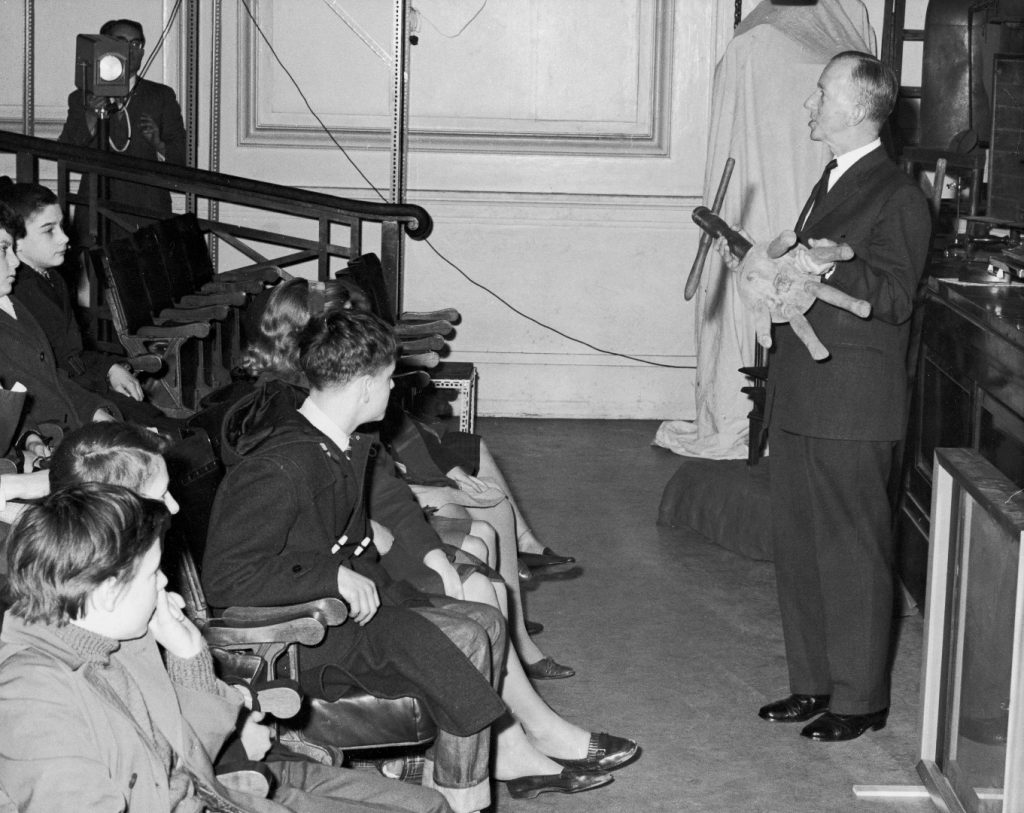
It is impossible to know if activity of this kind was often repeated, especially since there were Museum Assistants who aided the Lecturer with the setting up of demonstration equipment. But it seems plausible that they may well have taken this two-hander approach to special events such as the Christmas Lectures where they would have been keen to create an atmosphere that was even more exciting than usual. If this were so, then opportunities to watch more experienced Lecturers at work would have been plentiful. At the time of the photograph (Figure 3) van Riemsdijk would have been in the role for approximately one year, while Wall was already in his sixth year as Guide Lecturer.
It can be seen then, how a vertical transmission was established amongst the Guide Lecturers that endured until there was a move towards more informal methods of learning in the Museum.[23] In terms of connecting these practices to nineteenth-century methods, specifically those at the RI, and enhancing the Explainer lineage, we must return to the impact of the events in 1954.
After 1954: contemporary perspectives
https://dx.doi.org/10.15180/160604/009Taylor’s assertion that a critical element of repertoire transmission is presence, or ‘being there’ (2003, p 20), emphasises that it is the intrinsic interaction between presenter and audience which enables the passing on of practice. The fact that the form of the lecture-demonstrations performed at the RI has altered little in the two hundred years or so since they began suggests that this transmission of its repertoire is strong. The definite physical presence of the Guide Lecturers at certain of the RI lecture-demonstrations for schools in December 1954 affirms the appropriate conditions for the effective transmission of embodied knowledge and practices. As Taylor observes, the ‘repertoire […] allows scholars to trace traditions and influences’ (2003, p 20) and the Guide Lecturers’ conscious act of accepting and emulating the RI scientists’ methods and approaches as such, informs my own construction of the lineage from nineteenth-century scientist lecture-demonstrator to contemporary SMG Explainer. Returning to the Science Museum to continue with their own efforts to communicate the meanings and uses of science to school groups and beyond, the 1954 Guide Lecturers were both consciously and unconsciously contributing to the transmission of rituals and traditions, established elsewhere, that remain extant as an inherent part of its culture (Figure 4). The vertical transmission that existed amongst them facilitated an enduring sense of ‘againness’ (Taylor, 2003, p 21) as each new generation appropriated the embodied knowledge. Important to note here is that while the years in between the culmination of the Science Museum Lecture Service and contemporary Explainer practices (c.1986–2000) are not a feature of this essay, they are developed in my broader thesis, where a variety of presentation roles at the Science Museum that can be seen as providing a connection between the two are elaborated upon. For example, my wider doctoral project identifies a series of roles emerging during the 1980s at the Science Museum that I position as the next phase in the Explainer lineage following on from the Guide Lecturers. These are the Discovery Room assistant (1981–83), Test Bed assistant (1984–86) and early iterations of the Launch Pad assistant (1986–88).
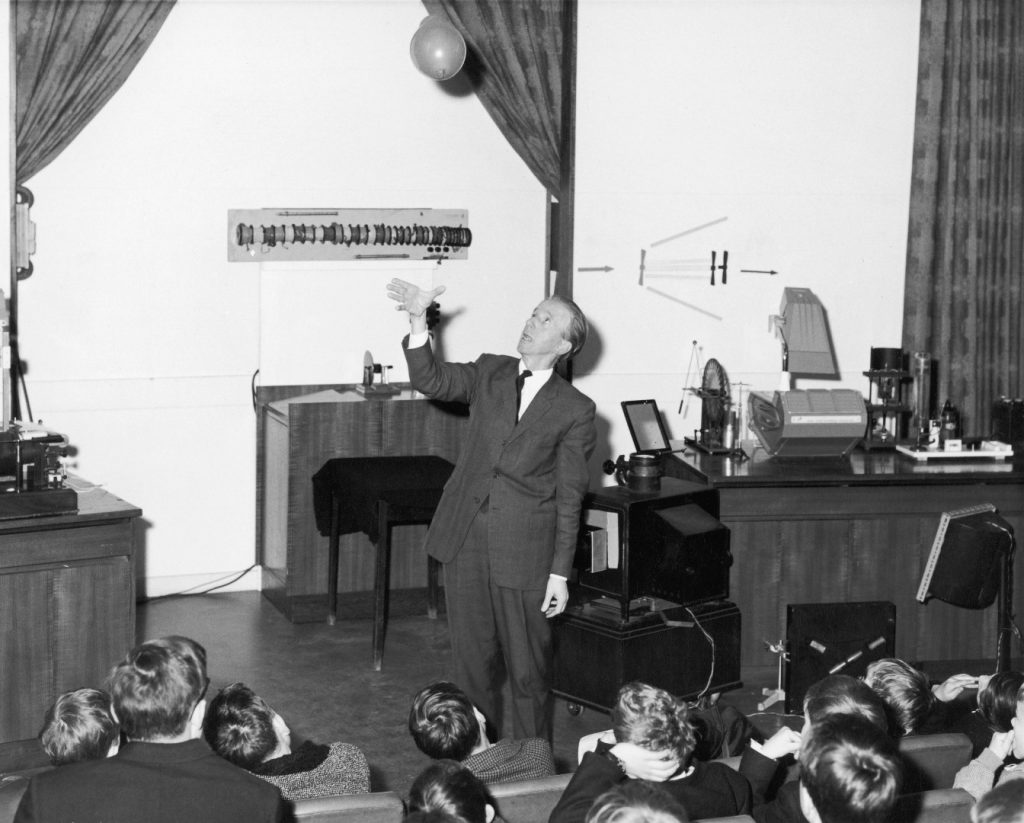
The Explainer-led science shows that were performed in the first part of the twenty-first century in Launch Pad[24] should be seen as the direct descendants of the lecture-demonstrations that began at the Science Museum in the mid-1950s, but, as I have suggested can also be seen as having roots in the practices of the nineteenth-century lecture-demonstrations at the RI. The Science Show format developed at the Science Museum has itself influenced other presentational forms adopted by Explainers at other SMG sites in the first part of the twenty-first century as it has developed a more overarching strategic influence.[25] My own participation as an audience member at some of these shows highlighted for me the fact that performance behaviours and actions are repeated and recurring across the sites. I suggest that this extends beyond the conscious intention on the part of the SMG to create a product that encapsulates the atmosphere of its Learning offer and can also be understood in terms that connect with Performance Studies concepts of ‘restored behaviour’ (Schechner, 2006), and the ‘recycling’ and ‘haunting’ (Carlson, 2003) of contemporary performance tropes by those from the past (Figure 5).
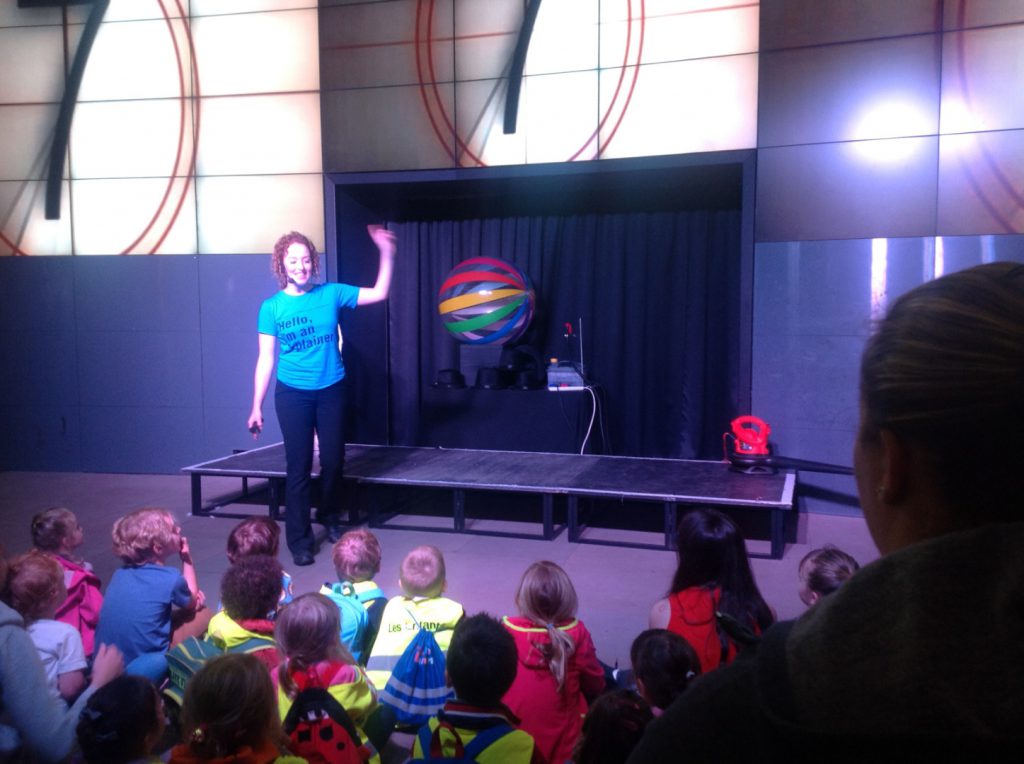
A former Science Museum Explainer who began working in Launch Pad in 1988 recalled that there was a period of time before the Explainer team became properly established and organised when they started to instinctively perform demonstrations:
The Explainers started doing them by themselves to be honest, there were a couple of Explainers I worked with early on that had done performances in the old gallery, the first gallery, but they were haphazard, they weren’t on a timetable, there was no training…they did bubbles and I think they did a water rocket, but it was pretty much left up to them to do it, it wasn’t at all managed. And then when we moved to the new gallery upstairs (…) there wasn’t actually a performance space, so they’d wiped performances from the menu, so there was nowhere that you could perform and no facility for it, but they’re funny the Explainers, you know, we just started doing them – we found a corner and we just started doing them, and of course crowds formed and the public loved it.[26]
This recollection reveals an intuitive capacity for performing demonstrations, the type of which has remained in the Explainer presentation repertoire to the present day. Significantly there is a sense that traces of the early performances referred to here found their way into later practices – they were reconstituted or recycled. In this way they can be regarded as an example of Schechner’s assertion that our behaviours are multi-authored and constructed via the many layers of social interactions and rituals that have occurred both in the recent and more distant pasts. His conceptualisation of individuals as the ‘synthesizers, recombiners, compilers or editors of already practiced actions’ (2002, p 35) suggests there can be no entirely new and unique behavioural inventions. In this sense, it is as though aspects of the practices adopted by the Guide Lecturers following their spectatorship of the December 1954 RI lectures were re-emerging in these haphazard, semi-improvised gallery performances in the late 1980s.
Conclusion
https://dx.doi.org/10.15180/160604/010Spectatorship of Bragg’s 1954 lecture-demonstrations at the RI resulted in traces of their forms remaining and residing intangibly in the memories and experiences of the Guide Lecturers. These intangible traces then re-appeared, in ‘continually moving, dissolving and re-forming pattern[s]’ (Bratton, 2003, p 38), as embodied elements in their own post-1954 performances of lecture-demonstrations at the Science Museum. In turn, those Science Museum practices were then recycled and transmitted to become inscribed in the traditions of performance in that institution, ultimately finding a route through various iterations of the 1980s assistant-type role, towards the contemporary performed work of the Explainer. This model offers a strong example of Diana Taylor’s notion of acts of behaviour that are played out in subtly different forms with each new iteration, as if memory is being replayed: ‘They reconstitute themselves, transmitting communal memories, histories, and values from one group/generation to the next’ (Taylor, 2003, p 20).
From this alternative narration of RI and Science Museum histories, focusing on the role of the Explainer through the lens of embodied knowledge transmission, I conclude that traces of the lecture-demonstration practices as first devised by Humphry Davy and emulated by other scientist-lecturers at the RI in the nineteenth century, will continue to reside in the embodied presentational practices of Explainers within the SMG. The attendance in 1954 of Science Museum Guide Lecturers at Bragg’s RI lectures thus established a critical intertheatrical (and inter-institutional) link in the Explainer lineage that not only brings together two significant public scientific organisations, but also ties, by a ‘slender, unbreakable thread’, popular contemporary explaining practices to a rich tradition of elite lecture-demonstration conventions.
Acknowledgements
I am grateful to all the SMG Explainers and Learning Managers past and present who have shared their experiences and thoughts with me and allowed me to observe them at work.
All references to the Lawrence Bragg Papers are by Courtesy of the Royal Institution of Great Britain.
Tags
Footnotes
Back to text
Back to text
Back to text
Back to text
Back to text
Back to text
Back to text
Back to text
Back to text
Back to text
Back to text
Back to text
Back to text
Back to text
Back to text
Back to text
Back to text
Back to text
Back to text
Back to text
Back to text
Back to text
Back to text
Back to text
Back to text
Back to text



